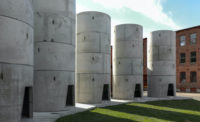Gone are the days of cramped, concrete cell–style dorm living—at the University of Arkansas, at least. At the beginning of the fall 2019 semester, students moved into Adohi Hall, a new, $79 million, 200,000 square-foot residence hall and living learning community, designed by Boston-based Leers Weinzapfel Associates in collaboration with St. Louis–based Mackey Mitchell Architects, Philadelphia’s OLIN, and the local Arkansian Modus Studio. The two-volume-timber complex, which covers four acres on the Fayetteville, Arkansas campus, is the university’s largest and newest residence hall, with the capacity to house 708 students.
Clad in aluminum panels with generous glazing, Adohi hall contrasts with older, Collegiate Gothic–style buildings on the campus, and its form challenges norms. “The mass timber design reimagines the traditional notion of campus housing as a building on a quad lawn,” Leers Weinzapfel Associates principal Tom Chung tells RECORD, instead channeling “a cabin in the woods, where building and landscape are woven together.” The architects used timber, a renewable resource with low embodied carbon, as “an example of a new sustainable way of building our campuses,” says Chung. Sustainably-sourced European spruce, pine, and fir trees make up the structure, with local cypress bringing warmth to interior detailing.
In addition to housing undergraduates, Adohi—named for the Cherokee word meaning “woods”—is also used to bring like-minded students studying architecture, design, and the arts together under one roof, encouraging a sense of community. Shared student rooms (2-person with a private bath, or pods for 12 to 16 with a communal bath and living room) are spread across four floors of the two buildings. Lounges, kitchens, and study rooms are sprinkled throughout the complex. And on the ground floor, a glass-walled common space (complete with several studios for art and music) connects the two L- and U-shaped volumes.








Post a comment to this article
Report Abusive Comment